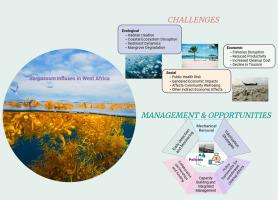Sargassum influxes in West Africa: Impacts, challenges, and prospects for sustainable management
IF 4.5
1区 生物学
Q1 MARINE & FRESHWATER BIOLOGY
引用次数: 0
Abstract
The causes and mechanisms behind the influx of Sargassum in West Africa are poorly understood. The lack of effective management and control measures negatively impacts fishing, tourism, and marine life, leaving coastal communities with insufficient adaptive strategies. Research on Sargassum in the region is limited, which may lead to an underestimation of the socio-economic impacts of the blooms. Regional efforts led by the Abidjan Convention Secretariat and the United Nations Environment Programme (UNEP) have yet to yield significant results. There are considerable gaps in funding, policy prioritization, capacity building, and access to technology for early detection and monitoring, all of which are essential for implementing an effective Sargassum management strategy. Between 2018 and 2023, estimates of stranded biomass across the tropical Atlantic ranged from 2 to 10 million tons annually, with West Africa contributing a smaller yet still significant share. The biochemical composition of West African Sargassum demonstrates some economic potential, though heavy metal contamination and monitoring challenges limit use, necessitating the need for targeted management and detoxification efforts. While Sargassum presents opportunities for innovation and sustainable economic use, resources for developing regional value chains are scarce. West Africa could benefit from a more deliberate collaborative transatlantic partnership, as well as from strengthening an integrated regional strategy to create scalable and sustainable solutions in research, policy, management, and practical applications.

西非马尾藻流入:可持续管理的影响、挑战和前景
马尾藻涌入西非的原因和机制尚不清楚。缺乏有效的管理和控制措施会对渔业、旅游业和海洋生物产生负面影响,使沿海社区缺乏适应战略。该地区对马尾藻的研究有限,这可能导致对藻华的社会经济影响的低估。由《阿比让公约》秘书处和联合国环境规划署(环境规划署)领导的区域努力尚未取得重大成果。在资金、政策优先顺序、能力建设和获得早期发现和监测技术方面存在相当大的差距,所有这些对于实施有效的马尾藻管理战略至关重要。2018年至2023年期间,估计每年热带大西洋搁浅的生物量在200万吨至1000万吨之间,西非贡献的份额较小,但仍然很大。西非马尾藻的生物化学成分显示出一定的经济潜力,尽管重金属污染和监测挑战限制了使用,因此需要有针对性的管理和解毒工作。虽然马尾藻提供了创新和可持续经济利用的机会,但发展区域价值链的资源稀缺。西非可以受益于一种更慎重的跨大西洋合作伙伴关系,也可以受益于加强一项综合区域战略,以便在研究、政策、管理和实际应用方面创造可扩展和可持续的解决方案。
本文章由计算机程序翻译,如有差异,请以英文原文为准。
求助全文
约1分钟内获得全文
求助全文
来源期刊

Harmful Algae
生物-海洋与淡水生物学
CiteScore
12.50
自引率
15.20%
发文量
122
审稿时长
7.5 months
期刊介绍:
This journal provides a forum to promote knowledge of harmful microalgae and macroalgae, including cyanobacteria, as well as monitoring, management and control of these organisms.
 求助内容:
求助内容: 应助结果提醒方式:
应助结果提醒方式:


